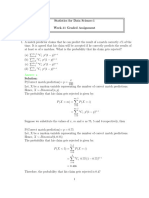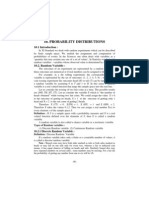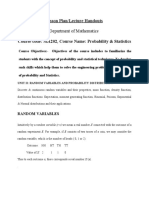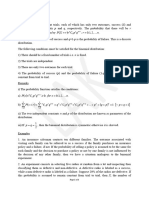070 Bernoulli Binomial
070 Bernoulli Binomial
Uploaded by
Juscal KwrldCopyright:
Available Formats
070 Bernoulli Binomial
070 Bernoulli Binomial
Uploaded by
Juscal KwrldCopyright
Available Formats
Share this document
Did you find this document useful?
Is this content inappropriate?
Copyright:
Available Formats
070 Bernoulli Binomial
070 Bernoulli Binomial
Uploaded by
Juscal KwrldCopyright:
Available Formats
– 1–
Will Monroe Lecture Notes #7
CS 109 July 10, 2017
Bernoulli and Binomial Random Variables
Based on a chapter by Chris Piech
There are some classic random variable abstractions that show up in many problems. At this point
in the class you will learn about several of the most significant discrete distributions. When solving
problems, if you are able to recognize that a random variable fits one of these formats, then you can
use its precalculated probability mass function (PMF), expectation, variance, and other properties.
Random variables of this sort are called “parametric” random variables. If you can argue that
a random variable falls under one of the studied parametric types, you simply need to provide
parameters. A good analogy is a class in programming. Creating a parametric random variable is
very similar to calling a constructor with input parameters.
Bernoulli Random Variable
A Bernoulli random variable is the simplest kind of random variable. It can take on two values,
1 and 0. It takes on a 1 if an experiment with probability p resulted in success and a 0 otherwise.
Some example uses include a coin flip, a random binary digit, whether a disk drive crashed, and
whether someone likes a Netflix movie.
If X is a Bernoulli random variable, denoted X ∼ Ber(p):
Probability mass function: P(X = 1) = p
P(X = 0) = (1 − p)
Expectation: E[X] = p
Variance: Var(X ) = p(1 − p)
Bernoulli random variables and indicator variables are two aspects of the same concept. As a
review, a random variable I is called an indicator variable for an event A if I = 1 when A occurs
and I = 0 if A does not occur. P(I = 1) = P( A) and E[I] = P( A). Indicator random variables are
Bernoulli random variables, with p = P( A).
Binomial Random Variable
A binomial random variable is random variable that represents the number of successes in n
successive independent trials of a Bernoulli experiment. Some example uses include the number
of heads in n coin flips, the number of disk drives that crashed in a cluster of 1000 computers, and
the number of advertisements that are clicked when 40,000 are served.
If X is a Binomial random variable, we denote this X ∼ Bin(n, p), where p is the probability of
success in a given trial. A binomial random variable has the following properties:
!
n k
P(X = k) = p (1 − p) n−k if k ∈ N, 0 ≤ k ≤ n (0 otherwise)
k
E[X] = np
Var(X ) = np(1 − p)
– 2–
Example 2
Let X = number of heads after a coin is flipped three times. X ∼ Bin(3, 0.5). What is the probability
of each of the different values of X?
!
3 0 1
P(X = 0) = p (1 − p) 3 =
0 8
!
3 1 3
P(X = 1) = p (1 − p) 2 =
1 8
!
3 2 3
P(X = 2) = p (1 − p) 1 =
2 8
!
3 3 1
P(X = 3) = p (1 − p) 0 =
3 8
Example 3
When sending messages over a network, there is a chance that the bits will be corrupted. A Hamming
code allows for a 4 bit code to be encoded as 7 bits, with the advantage that if 0 or 1 bit(s) are
corrupted, then the message can be perfectly reconstructed. You are working on the Voyager space
mission and the probability of any bit being lost in space is 0.1. How does reliability change when
using a Hamming code?
Image we use error correcting codes. Let X ∼ Bin(7, 0.1).
!
7
P(X = 0) = (0.1) 0 (0.9) 7 ≈ 0.468
0
!
7
P(X = 1) = (0.1) 1 (0.9) 6 = 0.372
1
P(X = 0) + P(X = 1) = 0.850
What if we didn’t use error correcting codes? Let X ∼ Bin(4, 0.1).
!
4
P(X = 0) = (0.1) 0 (0.9) 4 ≈ 0.656
0
Using Hamming Codes improves reliability by about 30%!
You might also like
- Homework 1Document4 pagesHomework 1Bilal Yousaf0% (1)
- Bernoulli and Binomial Random VariablesDocument2 pagesBernoulli and Binomial Random VariablesMohammad AslamNo ratings yet
- Discrete Distributions: Bernoulli Random VariableDocument27 pagesDiscrete Distributions: Bernoulli Random VariableThapelo SebolaiNo ratings yet
- Probability and Stochastic Process 21Document12 pagesProbability and Stochastic Process 21tarungajjuwaliaNo ratings yet
- class 4Document23 pagesclass 4saisawasiya31No ratings yet
- 08 The Poisson Probability DistributionDocument5 pages08 The Poisson Probability Distributionfehintolaolaniyi2021No ratings yet
- Tutorial 3: Robability Models & ApplicationsDocument17 pagesTutorial 3: Robability Models & ApplicationsUsman KhanNo ratings yet
- Lecture7 SlidesDocument4 pagesLecture7 SlidesphilopateerNo ratings yet
- Statistics 5Document3 pagesStatistics 5Sanchit SinglaNo ratings yet
- Sept 2017 - Final - With MemoDocument5 pagesSept 2017 - Final - With MemoBrian ZambeziNo ratings yet
- Topic 5 Discrete DistributionsDocument30 pagesTopic 5 Discrete DistributionsMULINDWA IBRANo ratings yet
- Chap 3Document18 pagesChap 3MELASHU ARAGIENo ratings yet
- Exercise 5Document6 pagesExercise 5Julia ŚwierczyńskaNo ratings yet
- ECS315 2014 Postmidterm U1 PDFDocument89 pagesECS315 2014 Postmidterm U1 PDFArima AckermanNo ratings yet
- Binom HandoutDocument21 pagesBinom Handoutsmorshed03No ratings yet
- Exercise 2Document2 pagesExercise 2ParanoidNo ratings yet
- Chương IIIDocument6 pagesChương IIIdaongoctrang911No ratings yet
- Lecture 4_CSE38900_rev1cDocument53 pagesLecture 4_CSE38900_rev1cxogix28490No ratings yet
- Tut 07Document3 pagesTut 07sarveshayaam2023No ratings yet
- Chapter 3: Probability: ExperimentDocument12 pagesChapter 3: Probability: Experimentnilesh bhojaniNo ratings yet
- Chapter 12 PDFDocument21 pagesChapter 12 PDFFetsum LakewNo ratings yet
- Notes DviDocument34 pagesNotes Dvicm.brgtransNo ratings yet
- Article 6Document33 pagesArticle 6mosesnaliakaNo ratings yet
- Week 11 Graded SolutionDocument10 pagesWeek 11 Graded SolutionjoshitabieberNo ratings yet
- Probability Space and Random Variable ProportiesDocument21 pagesProbability Space and Random Variable ProportieswandileNo ratings yet
- 13 Independent Random VariablesDocument34 pages13 Independent Random VariablesAntonio JNo ratings yet
- Answer: A: M 1 I 0 N I I N I M I 0 N I I N I M 1 I 1 N I I N I M I 1 N I I N IDocument9 pagesAnswer: A: M 1 I 0 N I I N I M I 0 N I I N I M 1 I 1 N I I N I M I 1 N I I N IkhhNo ratings yet
- 10 ProbabilityDocument38 pages10 Probabilitydurairajesakki6198No ratings yet
- Midterm 2: Sc-215 Probability and Statistics Winter 2012 Duration: 1HrDocument3 pagesMidterm 2: Sc-215 Probability and Statistics Winter 2012 Duration: 1HrHarshita AnandNo ratings yet
- 3.3 Bernoulli and Binomial DistributionsDocument3 pages3.3 Bernoulli and Binomial DistributionsTùng ĐàoNo ratings yet
- hwk4 SolnDocument6 pageshwk4 SolnHuy NguyễnNo ratings yet
- Entropy and Mutual InformationDocument4 pagesEntropy and Mutual InformationNishanth NazimudeenNo ratings yet
- Mutual InformationDocument4 pagesMutual InformationChandan GuptaNo ratings yet
- Mutinf PDFDocument4 pagesMutinf PDFmounikaNo ratings yet
- Chapter 3 Some Special Distributions: 3.1 The Binomial and Related DistributionsDocument127 pagesChapter 3 Some Special Distributions: 3.1 The Binomial and Related DistributionsAN NGUYENNo ratings yet
- Sampling Distributions: 1.1 Statistical InferenceDocument22 pagesSampling Distributions: 1.1 Statistical Inferencealvinakandwanaho3No ratings yet
- 6th Period Notes - Binomial and Geometric ProbabilityDocument8 pages6th Period Notes - Binomial and Geometric ProbabilityKinglt 2003No ratings yet
- Probability and StatisticsDocument20 pagesProbability and StatisticsamolaaudiNo ratings yet
- 03 PDFDocument22 pages03 PDFShashank JaiswalNo ratings yet
- Probability 2Document67 pagesProbability 2rodwayworkerNo ratings yet
- Ch1 Random Variables and Probability Distributions 0Document25 pagesCh1 Random Variables and Probability Distributions 0Gladzangel LoricabvNo ratings yet
- 1610 ST5214Document4 pages1610 ST5214Lee De ZhangNo ratings yet
- Important Random Variables: BinomialDocument15 pagesImportant Random Variables: Binomialsudhesh4u2003No ratings yet
- Statistical Models: Modeling and SimulationDocument51 pagesStatistical Models: Modeling and Simulationsourabh sagdeoNo ratings yet
- BMA2102 Probability and Statistics II Lecture 1Document15 pagesBMA2102 Probability and Statistics II Lecture 1bryan elddieNo ratings yet
- MGF, Discrete Statistical Distributions - 551Document49 pagesMGF, Discrete Statistical Distributions - 551SatheeskumarNo ratings yet
- Week 12 Exercises SolutionsDocument4 pagesWeek 12 Exercises SolutionsAbdul MNo ratings yet
- NotesDocument56 pagesNotesishanrajpurohit21No ratings yet
- chapter1Document15 pageschapter1Hù ngNo ratings yet
- CS19M016 PGM Assignment1Document9 pagesCS19M016 PGM Assignment1avinashNo ratings yet
- Qualifying Exam in Probability and Statistics PDFDocument11 pagesQualifying Exam in Probability and Statistics PDFYhael Jacinto Cru0% (1)
- Unit V Probability DistributionsDocument52 pagesUnit V Probability DistributionsabcdNo ratings yet
- Engineering Data Analysis Chap3Document37 pagesEngineering Data Analysis Chap3Perrie H.No ratings yet
- Unit 2 Ma 202Document13 pagesUnit 2 Ma 202shubham raj laxmiNo ratings yet
- 12.probability Distributions BinomialDocument3 pages12.probability Distributions Binomialshafayet.swe.sustNo ratings yet
- Wittenberg 2010 An Introduction To Maximum Entropy and Minimum Cross Entropy Estimation Using StataDocument16 pagesWittenberg 2010 An Introduction To Maximum Entropy and Minimum Cross Entropy Estimation Using StatatimobechgerNo ratings yet
- ProbabilityStatistics_Probability2 (1)Document11 pagesProbabilityStatistics_Probability2 (1)sandrataboadadacostaNo ratings yet
- Solution of Final Exam: 10-701/15-781 Machine Learning: Fall 2004 Dec. 12th 2004Document27 pagesSolution of Final Exam: 10-701/15-781 Machine Learning: Fall 2004 Dec. 12th 2004PRAKRITI SANKHLANo ratings yet
- Green's Function Estimates for Lattice Schrödinger Operators and ApplicationsFrom EverandGreen's Function Estimates for Lattice Schrödinger Operators and ApplicationsNo ratings yet
- Making Health Services Youth FriendlyDocument58 pagesMaking Health Services Youth Friendlysalug rhuNo ratings yet
- Automatic Strip Layout Design in Progressive Dies: Behrooz ArezooDocument17 pagesAutomatic Strip Layout Design in Progressive Dies: Behrooz Arezoomazen banatNo ratings yet
- 6-1 Video Lecture On Experimental Stress Analysis by Prof. K. Ramesh, IIT MadrasDocument22 pages6-1 Video Lecture On Experimental Stress Analysis by Prof. K. Ramesh, IIT MadrasarravindNo ratings yet
- Drawing Lesson - A Theory of Light and ShadeDocument37 pagesDrawing Lesson - A Theory of Light and ShadeHakan69No ratings yet
- Armix ACL Ver 6Document3 pagesArmix ACL Ver 6marimuthusakthi23No ratings yet
- On Whose Land Is The City - BeiraDocument17 pagesOn Whose Land Is The City - BeiraRic ParisNo ratings yet
- Mathematical Studies Internal Assessment: An Investigation Into The Probability of Winning Rock-Paper-ScissorsDocument12 pagesMathematical Studies Internal Assessment: An Investigation Into The Probability of Winning Rock-Paper-ScissorsIbrahim AlmalikNo ratings yet
- Department of Education: Minutes of 8B Homeroom Pta Meeting I. Date/ Venue Ii. Time Started Iii. Preliminary MattersDocument4 pagesDepartment of Education: Minutes of 8B Homeroom Pta Meeting I. Date/ Venue Ii. Time Started Iii. Preliminary MattersSheryl Jane SantiagoNo ratings yet
- 18A - Demand Forecasting Using Monte Carlo Simulation - 444e6071524350377afa5a76cdc8055Document9 pages18A - Demand Forecasting Using Monte Carlo Simulation - 444e6071524350377afa5a76cdc8055Divyam GargNo ratings yet
- Proficiency Testing For Determination of Water ConDocument7 pagesProficiency Testing For Determination of Water ConXimena AcNo ratings yet
- Doc-20240126-Wa0004 240126 094414Document46 pagesDoc-20240126-Wa0004 240126 094414Malak BenkaddourNo ratings yet
- Bishin Method Statement For Construction of Water Supply SystemDocument6 pagesBishin Method Statement For Construction of Water Supply Systemjuma jacobNo ratings yet
- College Wise Allotted ApllicantsDocument11 pagesCollege Wise Allotted ApllicantsshekhawatmahaveerNo ratings yet
- Lesson 27 MathDocument19 pagesLesson 27 MathMaria Vanissa Pansoy - MogelloNo ratings yet
- Compactblock I/O For Devicenet: Technical DataDocument36 pagesCompactblock I/O For Devicenet: Technical DataRodrigo Antonio TomazeliNo ratings yet
- Sscer 227681221Document1 pageSscer 227681221Aryan KumarNo ratings yet
- Mca 02 00127Document4 pagesMca 02 00127Abdullah Talha TuranNo ratings yet
- Lea 4 - Law Enforcement Operations & Planning With Crime Mapping (Obe-Cmo 5, S2018) Prelim Coverage - Week 1Document4 pagesLea 4 - Law Enforcement Operations & Planning With Crime Mapping (Obe-Cmo 5, S2018) Prelim Coverage - Week 1Paulo Justin Tabangcora OropillaNo ratings yet
- Investigatory Project SAMPLEDocument23 pagesInvestigatory Project SAMPLEAtty Rie Diamante100% (1)
- FYTEC - Fast Connector OPT-FT0Document3 pagesFYTEC - Fast Connector OPT-FT0diegopatriciomedinaNo ratings yet
- Assignment - Relations and FunctionsDocument2 pagesAssignment - Relations and FunctionsKOMAL AGGARWALNo ratings yet
- Minggu Ke-6: Nama: Sukma Krisna Herdianto NPM: 56419183 Kelas: 1IA02Document5 pagesMinggu Ke-6: Nama: Sukma Krisna Herdianto NPM: 56419183 Kelas: 1IA02Rahayu Fauziah Widiawanti SyifNo ratings yet
- GHASNTDocument12 pagesGHASNTrhinemineNo ratings yet
- Psychological SafetyDocument18 pagesPsychological Safetyritikasharma1406No ratings yet
- First Article Inspection (FAI) - What Is It and When Do You Need It?Document5 pagesFirst Article Inspection (FAI) - What Is It and When Do You Need It?prashanthNo ratings yet
- Chapter 3Document58 pagesChapter 3Suzan KhouryNo ratings yet
- Smart Goals LeoDocument2 pagesSmart Goals Leoapi-644490242No ratings yet
- PLO Civil 14-11-2017Document4 pagesPLO Civil 14-11-2017sawsan abdel dayemNo ratings yet
- Simulation of The Active Brownian Motion of A Microswimmer: 130.64.11.153 On: Fri, 26 Sep 2014 17:23:40Document7 pagesSimulation of The Active Brownian Motion of A Microswimmer: 130.64.11.153 On: Fri, 26 Sep 2014 17:23:40debdip1993No ratings yet
- Western PsychologyDocument9 pagesWestern PsychologyBrunda PsycheNo ratings yet

























































































